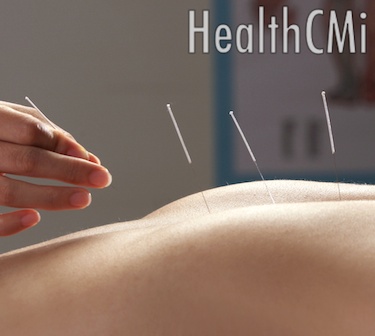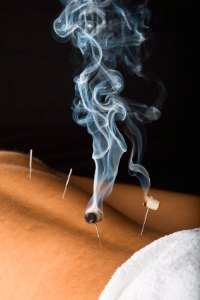Acupuncture successfully alleviates chronic fatigue syndrome (CFS). Researchers discovered that the application of manual acupuncture or acupuncture with warming needle moxibustion significantly reduces “physical and mental fatigue.” As a result of the investigation, the research team concludes that acupuncture provides a significant “therapeutic effect in the treatment of CFS.” 
Chronic fatigue syndrome is a debilitating disorder characterized by extreme fatigue that does not improve with rest and is exacerbated by physical and mental activity. Symptoms include exhaustion, weakness, musculoskeletal pain, poor memory and concentration, and insomnia.
Biomedicine does not identify a specific cause or cure for CFS and treatment focuses on alleviating symptoms. Lab tests and biomarkers specific to CFS are nonexistent. Several types of infections are considered risk factors for CFS including Epstein-Barr virus, human herpes virus 6, enterovirus, rubella, candida albicans, bornaviruses, mycoplasma, Ross River virus, coxiella burnetti and HIV. Sleep, antidepressant and pain relieving medications are often prescribed to patients to alleviate suffering.
Differential diagnostics within Traditional Chinese Medicine (TCM) categorizes CFS into several treatable patterns. The researchers chose acupuncture points best suited for the treatment of CFS based on TCM theory. The manual acupuncture group received needling at acupoints:
Baihui (GV20)
Danzhong (CV17)
Qihai (CV6)
Guanyuan (CV4)
Zusanli (ST36)
Hegu (LI4)
Taichong (LR3)
Sanyinjiao (SP6)
The warm needle acupuncture with moxibustion group received acupoint needling at:
Baihui (GV20)
Qihai (CV6)
Guanyuan (CV4)
Zusanli (ST36)
Additionally, acupuncture treatment was administered to a third group to test for acupuncture point specificity. Nearby points were chosen between 1 - 2 cm from the real acupuncture points. This type of approach varies from high quality sham acupuncture testing for the placebo effect wherein needles only appear to penetrate the skin. In the nearby point group, the researchers applied true acupuncture needling but not in the classic, exact locations as indicated in TCM:
Baihui (GV20)
Danzhong (CV17)
Qihai (CV6)
Guanyuan (CV4)
Zusanli (ST36)
Taichong (LR3)
Sanyinjiao (SP6)
Hegu (LI4)
Needling was applied to the points for all three groups at a rate of once per day for a total of twenty days. CFS was evaluated based on the Chalder Fatigue Scale, a fourteen item breakdown of symptoms. The nearby point group did show improvements in the physical score but only the manual acupuncture and warm needle moxibustion groups significantly improved in the physical and mental fatigue scores. The physical score was overwhelmingly better in the warm needle acupuncture group than the other groups.
 The nearby point needling group scored the lowest with a patient satisfaction rate of 35.7%. The acupuncture with warm needle moxibustion group scored the highest with a 72.7% patient satisfaction rate. This group achieved very high scores in both physical and mental improvements. The manual acupuncture group achieved a 36.2% effective rate.
The nearby point needling group scored the lowest with a patient satisfaction rate of 35.7%. The acupuncture with warm needle moxibustion group scored the highest with a 72.7% patient satisfaction rate. This group achieved very high scores in both physical and mental improvements. The manual acupuncture group achieved a 36.2% effective rate.
These results point to the superiority of warm needle moxibustion for the treatment of CFS for the point selections in the study design. Interestingly, CFS responds to nearby point stimulation for physical issues as long as the points are within 1 - 2 cm of the true acupuncture point, however, the results are nowhere near as effective as true acupuncture with moxibustion.
This type of testing has come under great scrutiny because TCM theory states that the so-called nearby points may be either Ah Shi acupuncture points or acupoints that stimulate relevant acupuncture channels. Nonetheless, this is an intriguing study that was able to get clinical results with three different clinical protocols. The significant success of warm needle moxibustion in achieving positive patient outcomes suggests that additional research into this approach to care is warranted.
A related study finds acupuncture 80.0% effective for the treatment of CFS. However, adding interferential current therapy to the treatment protocol raises the total effective rate to 93.3%. The complete recovery rate also benefitted from interferential therapy. Standard acupuncture protocols achieved a 20.0% total recovery rate within 20 acupuncture treatments for CFS patients in this acupuncture continuing education investigation. Adding interferential current therapy (ICT) increased the total recovery rate to 43.3%. The researchers conclude, “Electroacupuncture plus ICT can produce a remarkable efficacy in treating CFS.”
The Hubei University of Chinese Medicine study employed electroacupuncture protocols. Deqi was elicited using even reinforcing-reducing methods. Next, the needles were retained for 20 minutes. Based on individual patient diagnostics, between four and six acupuncture points were given electroacupuncture stimulation using a sparse-dense wave to a perceptibly tolerable intensity level. Acupuncture points needled in the study were:
GV20 (Baihui)
CV4 (Guanyuan)
CV6 (Qihai)
BL25 (Xinshu)
BL18 (Ganshu)
BL13 (Feishu)
BL20 (Pishu)
BL23 (Shenshu)
PC6 (Neiguan)
HT7 (Shenmen)
SP6 (Sanyinjiao)
ST36 (Zusanli)
A total of 5 - 7 of the acupoints were chosen for each patient using filiform needles of 0.30 mm diameter and 40 mm length to depths ranging from 1 - 1.3 cun. A total of 10 sessions comprised one course of care and two courses of care were administered.
A stereo dynamic interferential electrotherapy device was used for the ICT. Two groups of 4 X 4 cm electrodes were applied with a 5 kHz frequency. One group of electrodes was applied to the trapezius muscles and the other group was applied to the spine between acupuncture points BL15 and BL23. Intensity levels were set to patient tolerance levels wherein tingling could be felt at the site of the electrodes. ICT was applied for a total of 30 minutes per each treatment. A total of 10 ICT treatments comprised one course of care. Two courses of care were administered. A complete recovery was defined as all major symptoms and complications were completely resolved, the patient returned to a normal social life, and the patient returned to a normal work life and schedule. Achieving a total effective rate of 93.3% and a total recovery rate of 43.3% with acupuncture combined with ICT demonstrates that acupuncture plays an important role in the treatment of CFS. Furthermore, ICT demonstrates an important synergistic action when combined with acupuncture therapy.
References:
Lu, C., X. J. Yang, and J. Hu. "[Randomized controlled clinical trials of acupuncture and moxibustion treatment of chronic fatigue syndrome patients]." Zhen ci yan jiu= Acupuncture research/[Zhongguo yi xue ke xue yuan Yi xue qing bao yan jiu suo bian ji] 39, no. 4 (2014): 313-317.
Huang, Fang, Xiong Chen, Li-zhi Zhou, Ping Huang, and Li-hong Guo. "Clinical study on electroacupuncture plus interferential current therapy for chronic fatigue syndrome." Journal of Acupuncture and Tuina Science 12, no. 3 (2014): 156-159.


